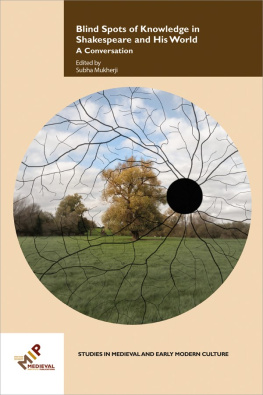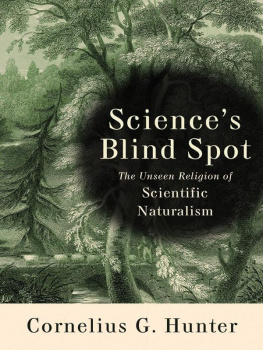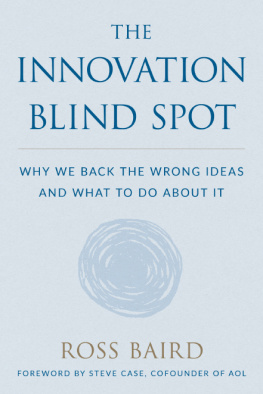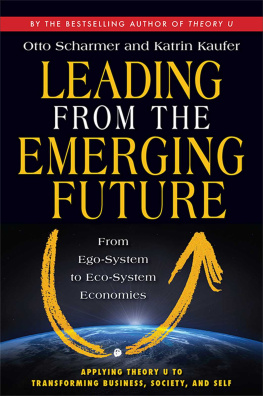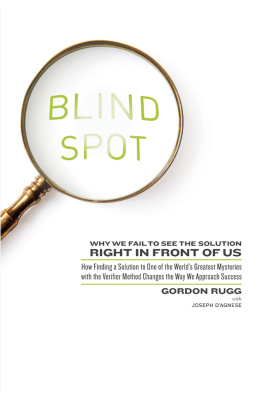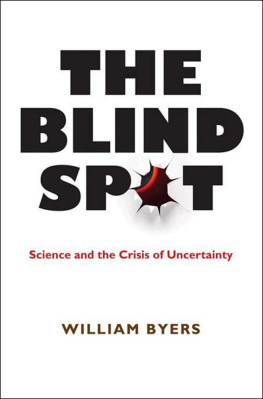Theory U
Theory U
Leading From the Future as it Emerges
THE SOCIAL TECHNOLOGY OF PRESENCING
C. OTTO SCHARMER

Theory U
Copyright 2009 by C. Otto Scharmer
All rights reserved. No part of this publication may be reproduced, distributed, or transmitted in any form or by any means, including photocopying, recording, or other electronic or mechanical methods, without the prior written permission of the publisher, except in the case of brief quotations embodied in critical reviews and certain other noncommercial uses permitted by copyright law. For permission requests, write to the publisher, addressed Attention: Permissions Coordinator, at the address below.

| Berrett-Koehler Publishers, Inc.
235 Montgomery Street, Suite 650
San Francisco, California 94104-2916
Tel: (415) 288-0260, Fax: (415) 362-2512
www.bkconnection.com |
Ordering information for print editions
Quantity sales. Special discounts are available on quantity purchases by corporations, associations, and others. For details, contact the Special Sales Department at the Berrett-Koehler address above.
Individual sales. Berrett-Koehler publications are available through most bookstores. They can also be ordered directly from Berrett-Koehler: Tel: (800) 929-2929; Fax: (802) 864-7626; www.bkconnection.com
Orders for college textbook/course adoption use. Please contact Berrett-Koehler: Tel: (800) 929-2929; Fax: (802) 864-7626.
Orders by U.S. trade bookstores and wholesalers. Please contact Ingram Publisher Services, Tel: (800) 509-4887; Fax: (800) 838-1149; E-mail: customer.service@ingrampublisherservices.com; or visit www.ingrampublisherservices.com/
Ordering for details about electronic ordering.
Berrett-Koehler and the BK logo are registered trademarks of Berrett-Koehler
Publishers, Inc.
First Edition
Paperback print edition ISBN 978-1-57675-763-5
PDF e-book ISBN 978-1-57675-866-3
IDPF e-book ISBN 978-1-60509-907-1
2010-3
Dedicated to
Katrin Kufer
Man knows himself only to the extent that he knows the world;
he becomes aware of himself only within the world,
and aware of the world only within himself.
Every object, well contemplated, opens up a new organ of
perception within us.
Johann Wolfgang v. Goethe
Foreword
PETER M. SENGE
Alongtime mentor of mine once said that the greatest of all human inventions is the creative process, how we bring forth new realities. Understanding the creative process is the foundation of genuine mastery in all fields. This knowledge is deeply embedded in the creative arts and, though rarely spoken of, defines those moments where there is magic in the air in theater, music, dance, and sports. It pervades the mysterious state of surrender whereby, in Michelangelos words, the sculptor releases the hand from the marble that holds it prisoner or, in Picassos statement, the mind finds its way to the crystallization of its dream. It plays no lesser role in science; as the economist W. Brian Arthur states: all great discoveries come from a deep inner journey. Against this backdrop of deeply shared but largely esoteric knowledge, Otto Scharmer suggests that the key to addressing the multiple unfolding crises of our timeand the future course of human developmentlies in learning how to access this source of mastery collectively.
Two predominant strategies characterize reactions to the unfolding environmental and social breakdowns evident in climate change, political paralysis and corruption, spreading poverty, and the failures of mainstream institutions of education, health care, government, and business: muddling through and fighting back. Muddling through is the strategy that characterizes most of us in the rich northern countries. It embraces a combination of working to preserve the status quo combined with an almost hypnotic fascination with wondrous new technologies that, so the belief goes, will solve our problems. Fighting back, as is evident in the vocal protests of millions of people around the world opposed to the Washington consensus view of globalization, combines a longing for an earlier social and moral order with anger at having lost control over our future.
But beyond surface differences, the two strategies and their adherents are not as dissimilar as they may first appear. Manyperhaps mostof the muddlers share a pervasive uneasiness. This is evident in anxiety about the future, growing dissatisfaction with and distrust of virtually all social institutions, and withdrawal from public discourse and civic engagement. Even those who say little about it sense that deep imbalances exist in the global industrialization process and that these threaten to worsen. But there is little hope that anything can be done about them; hence we carry on carrying on. Perhaps the ultimate irony is that even the most ardent technological optimists feel deep down that the course of technology development shapes itself and that there is little that can be done about it. Likewise, many of those fighting back share similar fatalistic feelings of trying to stop immutable forces, as evidenced by the anger and violence of their actions. As a dear friend and recognized leader in the environmental movement recently confided, I am becoming convinced that many of the most aggressive environmentalists believe that the human species is deeply flawed and does not deserve to survive. Last, both strategies are anchored in the past: advocates of the status quo future basically extrapolate what they regard as positive trends from the past; opponents fight these trends.
Otto Scharmers Theory U embodies a third view, one that I believe is growing around the world. This view holds that the future will, inevitably, be very different from the past, simply because the predominant trends that have shaped global industrial development cannot continue. We cannot continue to concentrate wealth in a world of growing interdependence. We cannot continue to expand the take, make, waste industrial model in a world where there is, increasingly, no away to throw our waste and toxins to. We cannot continue to put more and more carbon into the atmosphere, when carbon dioxide concentration is already 30 percent higher than at any time in the past 450,000 years and carbon dioxide emissions are already at three to five times the rate at which the substance is being removed from the atmosphere. Second, this view holds that we are not powerless to alter the dominant trends of the industrial age. These trends are based not on the laws of physics but on human habits, albeit habits on a large scale. These habitual ways of thinking and acting become embedded over time in social structures we enact, but alternative social structures can also be created. Achieving the changes needed means nothing less than creating the world anew, based on a radically different view, as you will see below, of our collective capacity to, as Martin Buber put it, Listen to the course of being in the world and bring it to reality as it desires.
As a friend and partner of Otto Scharmer for more than ten years now in developing this work, I have been waiting for this book, as have many of our colleagues. Without question, we regard Otto as the premier theorist of the U methodology. Moreover, his extensive practical experience, especially in long-term systemic change projects, gives him a unique depth of understanding of the challenges and possibilities of applying the methodology.
Next page

